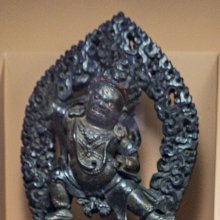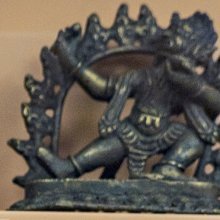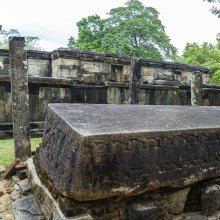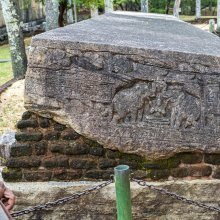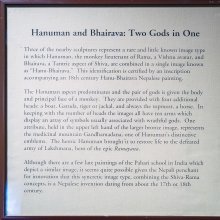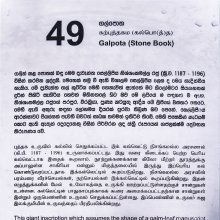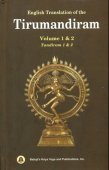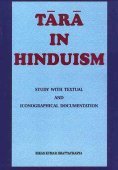Heroic: 3 definitions
Introduction:
Heroic means something in Hinduism, Sanskrit. If you want to know the exact meaning, history, etymology or English translation of this term then check out the descriptions on this page. Add your comment or reference to a book if you want to contribute to this summary article.
Images (photo gallery)
(+1 more images available)
In Hinduism
Gitashastra (science of music)
Source: Shodhganga: Elements of Art and Architecture in the Trtiyakhanda of the Visnudharmottarapurana (gita)The Heroic Sentiment (in Sanskrit: vīra-rasa) refers to one of the nine kinds of Sentiment (rasa) in Indian classical Music. They have an inherent relationship with the svaras (“musical notes”).—There are nine kinds of sentiments: [e.g., Heroic (vīra)]. In the Nāṭyaśāstra some particular svaras are determined for the delineation of some specific sentiments. In the Nāṭyaśāstra it is accepted that—the notes ṣadja and ṛṣabha are used to delineate the sentiments of vīra, raudra and adbhuta.
Gitashastra (गीतशास्त्र, gītaśāstra) refers to the ancient Indian science of Music (gita or samgita), which is traditionally divided in Vocal music, Instrumental music and Dance (under the jurisdiction of music). The different elements and technical terms are explained in a wide range of (often Sanskrit) literature.
Natyashastra (theatrics and dramaturgy)
Source: Shodhganga: Elements of Art and Architecture in the Trtiyakhanda of the Visnudharmottarapurana (natya)The Heroic Sentiment is denoted by the Sanskrit term Vīra-rasa, which represents one of the nine kinds of Rasa (“soul of Drama”), according to the Viṣṇudharmottarapurāṇa, an ancient Sanskrit text which (being encyclopedic in nature) deals with a variety of cultural topics such as arts, architecture, music, grammar and astronomy.—According to the Viṣṇudharmottarapurāṇa gaura i.e., radish white is the colour of this sentiment. Mahendra is the God of this sentiment. The Nāṭyaśāstra states that the vīrarasa relates to the superior type of persons and has excitement as its basis. Utsāha is the sthāyibhāva of vīrarasa. This sentiment is enacted in stage through the consequents like firmness, heroism, sacrifice, diplomacy and the like.

Natyashastra (नाट्यशास्त्र, nāṭyaśāstra) refers to both the ancient Indian tradition (shastra) of performing arts, (natya—theatrics, drama, dance, music), as well as the name of a Sanskrit work dealing with these subjects. It also teaches the rules for composing Dramatic plays (nataka), construction and performance of Theater, and Poetic works (kavya).
Shilpashastra (iconography)
Source: Shodhganga: Elements of Art and Architecture in the Trtiyakhanda of the Visnudharmottarapurana (shilpa)The Heroic (sentiment) refers to one of the Nine Sentiments (citrarasa) in ancient Indian Painting (citra), according to the Viṣṇudharmottarapurāṇa, an ancient Sanskrit text which (being encyclopedic in nature) deals with a variety of cultural topics such as arts, architecture, music, grammar and astronomy.—Painting is a medium of showing the inner feelings and emotions of a painter which can strikes the inherent sentiments of connoisseur’s mind [e.g., the heroic sentiment (vīra)]. [...] In a picture, vīrarasa i.e., heroism can be reflected through the display of prowess along with a noble look of promise and firmness of the person drawn in the picture. According to the Viṣṇudharmottarapurāṇa, sometimes heroism can be shown with raised eyebrows also.

Shilpashastra (शिल्पशास्त्र, śilpaśāstra) represents the ancient Indian science (shastra) of creative arts (shilpa) such as sculpture, iconography and painting. Closely related to Vastushastra (architecture), they often share the same literature.
See also (Relevant definitions)
Full-text (+697): Vira, Shauryakarman, Virarasa, Virenya, Virasana, Mardai, Atishaktita, Mardumaki, Mardumi, Mardin, Itihasa, Dhamavat, Mardagaji, Vir, Vikramin, Virabhava, Utsahavardhana, Yuddhavira, Vyayoga, Viravat.
Relevant text
Search found 148 books and stories containing Heroic; (plurals include: Heroics). You can also click to the full overview containing English textual excerpts. Below are direct links for the most relevant articles:
Bhagavati-sutra (Viyaha-pannatti) (by K. C. Lalwani)
Dasarupaka (critical study) (by Anuru Ranjan Mishra)
Part 9 - Sentiments (rasa) used in a Vyāyoga < [Chapter 5 - Vyāyoga (critical study)]
Part 9 - Sentiments (rasa) used in a Īhāmṛga < [Chapter 9 - Īhāmṛga (critical study)]
Part 9 - Sentiments (rasa) used in a Nāṭaka < [Chapter 1 - Nāṭaka (critical study)]
'The Heroic Mother' < [December 1938]
Utopias: Their Significance < [January 1956]
Utopias: Their Significance < [January 1956]
Guhyagarbha Tantra (with Commentary) (by Gyurme Dorje)
Text 15.36 (Commentary) < [Chapter 15 (Text and Commentary)]
Text 15.35 (Commentary) < [Chapter 15 (Text and Commentary)]
Text 15.34 (Commentary) < [Chapter 15 (Text and Commentary)]
Dramaturgy in the Venisamhara (by Debi Prasad Namasudra)
The Relationship of the different phases of Rasas < [Chapter 4 - Dramaturgy in Veṇīsaṃhāra]
The Hero of the Dramatic Play < [Chapter 4 - Dramaturgy in Veṇīsaṃhāra]
Description of Samavakāra < [Chapter 2 - Nature and Classification of Sanskrit Drama]
Ramayana (by Manmatha Nath Dutt)
Chapter XVII < [Book 1 - Bāla-kāṇḍa]
Chapter LXXI < [Book 1 - Bāla-kāṇḍa]
Chapter L < [Book 1 - Bāla-kāṇḍa]
Related products
